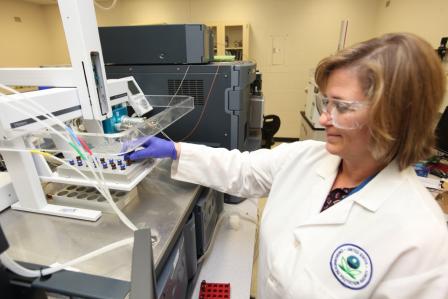Meet EPA Scientist Jody Shoemaker, Ph.D.
 EPA researcher Jody Shoemaker sets up a liquid chromatography/tandem mass spectrometer for an injection and analysis. EPA research chemist Jody Shoemaker, Ph.D., works to support Agency efforts to protect drinking water. She helps develop methods for analyzing organic chemicals on the Drinking Water Contaminant Candidate List (CCL)—the primary source of priority contaminants for which the Agency conducts research to decide whether protective regulations are needed. The methods Dr. Shoemaker works on are adopted into Federal Regulations for monitoring drinking water under the Safe Drinking Water Act and used in “ Unregulated Contaminant Monitoring Regulations.” In her spare time, Dr. Shoemaker is an avid reader and enjoys cooking and horseback riding.
EPA researcher Jody Shoemaker sets up a liquid chromatography/tandem mass spectrometer for an injection and analysis. EPA research chemist Jody Shoemaker, Ph.D., works to support Agency efforts to protect drinking water. She helps develop methods for analyzing organic chemicals on the Drinking Water Contaminant Candidate List (CCL)—the primary source of priority contaminants for which the Agency conducts research to decide whether protective regulations are needed. The methods Dr. Shoemaker works on are adopted into Federal Regulations for monitoring drinking water under the Safe Drinking Water Act and used in “ Unregulated Contaminant Monitoring Regulations.” In her spare time, Dr. Shoemaker is an avid reader and enjoys cooking and horseback riding.
- Contaminant Candidate List (CCL) and Regulatory Determinations Home
- Unregulated Contaminant Monitoring Program
How does your science matter?
My research involves developing methods to find chemicals in drinking water. EPA is required to establish a list of contaminants that may be found in water that EPA considers for future regulation. One of the key pieces of information used to decide if a contaminant should be regulated is data that shows what contaminants are found around the country in drinking water.
My lab develops methods that will produce data for monitoring unregulated chemicals. These methods will provide accurate monitoring of chemicals of emerging concern in drinking water. Better monitoring data, provided by our methods, assists EPA in making decisions, and helps safeguard the nation’s drinking water supply from harmful drinking water contaminants.
What do you like most about your research?
I like the challenge of developing analytical methods for difficult chemicals which sometimes requires thinking outside the box. In addition, knowing that the methods I produce will be used in a meaningful way to protect drinking water—and public health—makes me enjoy my job.
When did you first know you wanted to pursue science?
I had a wonderful 10th grade high school chemistry teacher who instilled in me a love for chemistry. I knew after that class that chemistry was what I wanted to study in college.
If you were not a scientist, what would you be doing?
My second favorite subject in school was always math. If I weren't a scientist, I suspect maybe a career in accounting or actuary would have appealed to me.
Tell us about your science/educational background.
I have a B.S. in Chemistry from Notre Dame College of Ohio and a Ph.D. in Analytical Chemistry from the University of Florida. My dissertation involved estimating mutagenic/carcinogenic potential of environmental contaminants by ion-molecule reactions and tandem mass spectrometry. I came to the EPA directly from graduate school and have worked here since 1991.
Any advice for students considering a career in science?
I would highly recommend that students do as many internships or summer undergraduate research programs as possible. Those programs help students determine if they really enjoy science, as well as aid them in exploring which of the many fields of science they find most interesting.
Editor's Note: The opinions expressed herein are those of the researcher alone. EPA does not endorse the opinions or positions expressed.
